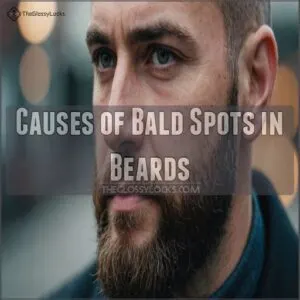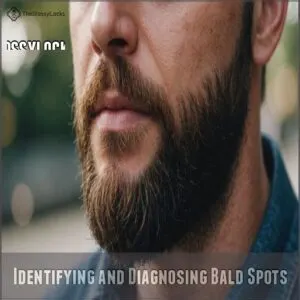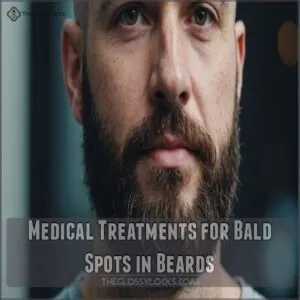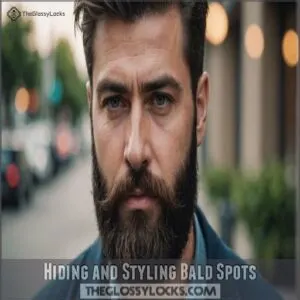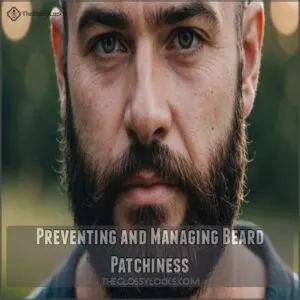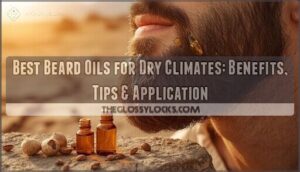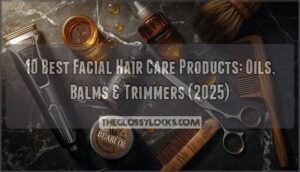This site is supported by our readers. We may earn a commission, at no cost to you, if you purchase through links.
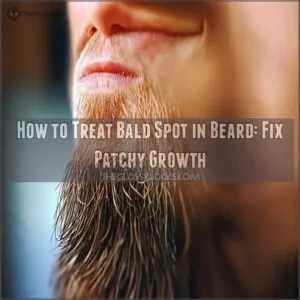
First, you should eat a healthy diet and manage stress; these factors impact hair growth.
Consider minoxidil, a topical treatment that can stimulate follicles.
Let your beard grow naturally to see its full potential.
Good beard care, including gentle washing and conditioning, is essential.
Smart beard styling can also camouflage minor imperfections.
But what if your spot’s stubborn? There are more advanced options we’ll explore…
Table Of Contents
- Key Takeaways
- Causes of Bald Spots in Beards
- Identifying and Diagnosing Bald Spots
- Medical Treatments for Bald Spots in Beards
- Hiding and Styling Bald Spots
- Preventing and Managing Beard Patchiness
- Embracing Your Unique Beard Growth Pattern
- Frequently Asked Questions (FAQs)
- How do you treat a bald patch in a beard?
- Is there a cure for balding?
- What causes a bald spot in your beard?
- How to hide a bald beard?
- Is there a way to fix bald spots in a beard?
- How can I regrow my beard patch?
- Is it possible to regrow hair on a bald spot?
- Does patchy beard mean low testosterone?
- Can diet impact beard baldness recovery?
- Are bald spots in beards hereditary?
- How long do beard bald spots last?
- Do essential oils resolve beard baldness?
- Can stress worsen beard bald spots?
- Conclusion
Key Takeaways
- Focus on a healthy diet and manage stress, as these factors significantly impact beard growth and can help treat bald spots.
- Explore medical treatments like minoxidil or corticosteroids to stimulate hair regrowth and tackle patchy areas effectively.
- Use smart beard styling techniques and grooming products like oils and balms to camouflage bald spots while enhancing your beard’s appearance.
- Embrace natural remedies and supplements, such as essential oils and beard growth vitamins, to support hair health and potentially speed up recovery.
Causes of Bald Spots in Beards
You might find those bald spots in your beard are just as stubborn as that one sock that always goes missing.
These patches can be caused by autoimmune conditions, dermatological issues, or even your hair care routine, making it important to identify the underlying factors.
Autoimmune Conditions
Spotting bald patches in your beard can be puzzling, often linked to autoimmune conditions like alopecia areata. Your immune system mistakenly targets hair follicles, causing beard hair loss. This condition, also known as alopecia barbae diagnosis, involves a mix of genetics, stress, hormonal imbalance, and lifestyle changes.
Tackling this involves:
- Understanding Stress Impact
- Exploring Treatment Options
- Considering Lifestyle Changes
- Recognizing Beard Alopecia
- Thinking About Beard Transplant
Empathize with your beard—it’s not always simple!
Dermatological Conditions
If your beard’s got more gaps than a jigsaw puzzle missing pieces, dermatological conditions might be the culprit.
Folliculitis, skin infections, or Beard Psoriasis could lead to patchy growth.
It’s important to address issues like dermatitis and eczema, which may trigger beard baldness.
Be proactive—consult a dermatologist and explore options from topical treatments to a possible beard transplant.
Mechanical Conditions
Your beard’s enemy could be your razor.
Shaving too aggressively might lead to skin irritation, ingrown hairs, and even folliculitis, causing a patchy beard.
Avoid trauma by being gentle and using quality products to prevent beard hair loss.
Remember, your beard growth journey is its own adventure, so keep up with beard care to dodge alopecia barbae!
Styling Damage
Ever wonder if your beard styling habits are causing harm?
Over-brushing, tight braids, and excessive heat styling can lead to bald spots, also known as traction alopecia.
Using harsh hair products can weaken hair, resulting in beard hair loss.
To maintain healthy beard growth, focus on gentle beard trimming techniques and consider less damaging alternatives in your beard styling routine.
Genetics and Hormonal Imbalance
Some men face bald spots in their beards due to genetics and hormonal imbalances, much like how others deal with stubborn cowlicks.
Understanding your genetic predisposition helps.
Incorporating supplements like beard growth vitamins can help address underlying nutritional deficiencies that may contribute to patchy growth.
Hormonal testing can reveal testosterone level issues or identify if DHT blockers could assist.
Sometimes, considering a beard transplant addresses androgenetic alopecia effectively.
Embrace your unique beard story—it’s yours!
Stress and Psychological Factors
Beyond genetics, stress plays a surprisingly big role.
High-stress levels can impact your body’s ability to grow hair, leading to patchy beards.
Think of it as your body prioritizing survival over follicles!
Practicing stress management techniques, like meditation or exercise, might help.
If stress is a major factor, seeking emotional support could be beneficial.
Remember, a healthy mind contributes to a healthy beard.
Identifying and Diagnosing Bald Spots
Let’s unravel the mystery of those beard bald spots.
You’ve noticed hair loss patterns, and it’s time to figure out what’s going on.
Start with a simple visual inspection.
Grab a mirror and check for small, circular patches.
Ask yourself: Are they smooth or irritated?
If you’re into self-diagnosis, keep an eye out for exclamation mark hairs—they’re narrow at the base and can signal trouble.
Jot down any itching or pain, as they’re clues too.
Maybe consider home remedies or set up medical tests if it looks tricky.
Identifying the issue is your first step toward beard health and growth solutions.
Here’s to a patch-free, glorious beard that’s all about confidence and style!
- Have you noticed any itching?
- Are there white hairs around bald spots?
- Is the bald spot smooth or rough?
- Do patches appear suddenly?
- Consider any recent stress factors.
Medical Treatments for Bald Spots in Beards
Addressing bald spots in your beard often involves medical treatments like corticosteroids and minoxidil to encourage regrowth.
While these options might sound complex, they’re generally straightforward and can effectively boost your beard’s fullness with consistent use.
Corticosteroids and Minoxidil
Imagine this: you’ve spotted a patchy beard and need solutions.
Corticosteroids can soothe the immune system’s pesky attacks on hair follicles, helping them recover.
Minoxidil, famed for its hair growth prowess, can foster beard growth and restore those spots.
Watch for side effects and follow application tips.
Your journey to fuller facial hair demands patience, so stick with it for lasting results.
Diphencyprone (DPCP) and Anthralin
Corticosteroids work wonders for some, but DPCP and anthralin offer unique perks for treating patchy beards.
Here’s the scoop:
- DPCP causes mild irritation, nudging regrowth.
- Anthralin application can darken skin temporarily.
- Compare treatments: DPCP vs. anthralin for best fit.
- Success rates vary, so patience is key.
Addressing those bald spots takes some science!
Natural Remedies and Supplements
Tackling a patchy beard involves exploring natural remedies that blend science and simplicity.
Boosting beard growth with the right nutrients, like those found in beard vitamins and minerals, can make a difference. Supplements for beard growth, like biotin and zinc, can lend a hand.
Essential oils for beard care, such as rosemary and lavender, offer benefits for beard growth.
Embrace a varied diet for beard growth, featuring proteins and healthy fats, to nourish follicles from within.
Home Remedies and Lifestyle Changes
While natural remedies offer potential benefits, let’s explore how home remedies and lifestyle changes can boost your beard growth, considering factors such as autoimmune disorders like alopecia areata.
Focus on maintaining a balanced diet rich in proteins and vitamins, manage stress effectively, make sure you get enough sleep, and stay hydrated.
Choose gentle beard products to support the growth stages and enjoy every beard growth rate.
Adapt your routine; your patchy beard depends on it.
Hiding and Styling Bald Spots
Don’t let a few bald spots ruin your beard game! This section explores simple styling tricks and grooming techniques to cleverly conceal those patchy areas and create a fuller-looking beard.
Letting Your Beard Grow and Brushing It
Your beard’s patchy spots can be cleverly hidden by letting it grow out.
As your beard matures, a good beard care routine and the right beard brush types make a real difference.
Regular brushing is key to a fuller beard, as using beard oil and balm can nourish and hydrate facial hair, promoting healthy growth and reducing itchiness. Regular brushing not only styles but also trains hair to cover bald patches.
Use these beard grooming tips to enhance growth stages and avoid beard styling mistakes.
Trimming and Shaping Your Beard
Mastering your beard’s look can cleverly disguise patchy spots.
Use beard trimming techniques to even out growth, shaping styles to complement your face.
To tackle patchy beard growth and create a more balanced look, consider embracing a clean-shaven head, as seen in clean shaven looks, and focus on styling the rest of your beard. A clean fade style or careful trimming can hide those pesky gaps.
Regular maintenance tips keep your beard sharp, while proper tools guarantee precision.
Remember, confidence in your beard style goes a long way in boosting your appearance!
Using Beard Oils and Balms
Transform your patchy beard into a masterpiece with beard oils and balms.
By incorporating these into your beard care routine, you can:
- Nourish those dry spots: Keep them soft and hydrated.
- Boost growth: Give your facial hair the nutrients it craves, and consider using a beard follicle stimulant beard growth treatment to enhance results.
- Style easily: Tame unruly hairs for a fuller look.
Oil types for beards vary, so find your perfect match!
Seeking Advice From a Professional Barber
Need a fresh perspective on your patchy beard?
A professional barber is your secret weapon.
They’ll offer beard style recommendations and trimming techniques suited to your facial structure.
Don’t fret over bald spots; instead, embrace them with the right advice.
Here’s a quick guide:
| Aspect | Details |
|---|---|
| Professional Insight | Expert styling tips |
| Personalized Advice | Advice specific to your needs |
| Product Suggestions | Recommended beard growth products |
| Confidence Boost | Style that suits you best |
Preventing and Managing Beard Patchiness
To keep your beard looking full and healthy, focus on regular trimming and use beard growth vitamins to boost growth.
Protecting your skin and managing stress are simple steps that can prevent pesky patches from appearing.
Trimming and Maintaining Your Beard
Spotting those bald patches might tempt you to grow a longer beard for coverage. But regular trimming and maintenance work wonders in managing patchiness, as understanding patchy beard styles is key to finding the best approach for your unique growth patterns.
Use top-quality beard trimming tools to keep things tidy.
Enhance growth and shine with beard oil benefits.
Try different beard comb styles for a smart look.
- Trimming promotes healthy growth
- Oil aids in nourishment
- Comb styles add flair
Using Beard Growth Vitamins and Supplements
Maintaining a well-groomed beard is only half the battle.
Now, let’s talk beard vitamins and supplements.
These can help boost your beard’s growth.
Look for reputable brands, and always check for potential side effects.
Remember, proper vitamin dosage is key.
While real results vary, many guys swear by them for thicker, fuller facial hair.
Research different beard supplements and find what works for you.
Consider natural beard growth options too; they might surprise you!
Protecting Your Skin and Hair From Damage
To fend off beard patchiness, safeguard your skin and hair from damage by focusing on daily care.
Consider these steps:
- Optimize beard hygiene: Choose the right products to avoid irritants like beard psoriasis and seborrheic dermatitis.
- Use sun protection: Prevent damage by applying sunscreen to your beard.
- Invest in proper tools: Maintain a solid hair care routine with quality combs and brushes.
Managing Stress and Hormonal Imbalance
As you protect your skin and hair, remember that stress and hormonal imbalances can also cause patchy beard growth.
Incorporate stress-reduction techniques and consider hormone testing for better management.
Lifestyle changes like diet modifications and sleep hygiene can work wonders.
Explore these practical tips to tackle hormone-related thinning with confidence.
| Method | Benefit | Example |
|---|---|---|
| Stress Reduction | Enhances Growth | Meditation |
| Diet Modifications | Improves Follicle Health | Omega-3 Rich Foods |
| Sleep Hygiene | Balances Hormones | Consistent Sleep Routine |
Embracing Your Unique Beard Growth Pattern
You can’t change your genetics, but embracing your unique beard growth pattern can lead to a more authentic and confident you.
Find the style that fits you best, and remember, a patch here or there adds character, just like a celebrity’s quirky habit.
Accepting Genetics and Hormonal Factors
Sometimes, genetics and hormones play a significant role in your beard growth potential.
Embrace your unique pattern by accepting imperfections and considering hormonal testing if worried.
Family history might reveal reasons behind patchy beard areas, a common challenge for many.
Age-related thinning is normal, but lifestyle changes and hair loss treatments can maximize your growth potential.
Keep your beard advice simple and empowering.
Finding The Right Beard Style for You
Feeling outmatched by genetics?
Embrace your beard’s natural pattern by finding a style that complements your face shape.
Consider addressing any beard hair loss with effective beard hair loss treatments.
Whether it’s sleek or rugged, an ideal beard style can showcase your individuality.
Check current beard trends for style inspiration, keeping men’s health and grooming tips in mind.
Remember, a great beard starts with care—and maybe a dab of beard balm!
Building Confidence and Self-Acceptance
Embrace your patchy beard like it’s a unique fingerprint of your personality.
Confidence starts by accepting your beard’s quirks as part of your positive self-image.
Cultivate self-love by focusing on what makes your growth special.
Acknowledge each uneven spot as a badge of individuality that enhances your body image.
Remember, acceptance isn’t just powerful—it’s the ultimate expression of true confidence.
Frequently Asked Questions (FAQs)
How do you treat a bald patch in a beard?
To treat a bald patch in your beard, consult a dermatologist for options like corticosteroids or minoxidil to promote growth.
You might also try natural oils, stress reduction, or support groups for emotional resilience.
Persistence pays!
Is there a cure for balding?
You can’t cure balding entirely, but you can manage it.
Treatments like minoxidil or finasteride can promote hair growth.
A healthy lifestyle and stress management may also help.
Consult a dermatologist for personalized advice and options.
What causes a bald spot in your beard?
A bald spot in your beard might come from alopecia barbae, where your immune system attacks hair follicles.
Stress, genetics, family history of autoimmune diseases, or conditions like folliculitis and scarring alopecia can also play roles.
How to hide a bald beard?
Ever wondered why some beard bald spots elude cover-up attempts?
Try styling your beard by letting it grow slightly longer, using beard balm or oil for structure, or consulting a barber for a personalized grooming strategy.
Is there a way to fix bald spots in a beard?
Fixing bald spots in a beard can be achieved by first identifying the underlying cause, such as alopecia areata symptoms, which is crucial for effective treatment. Fixing bald spots in a beard involves using treatments like minoxidil, corticosteroids, or natural oils such as castor oil.
Embrace your unique growth, and consult a dermatologist for personalized advice.
Patience and routine are key to improvement.
How can I regrow my beard patch?
Try minoxidil or beard growth oils, as natural remedies like castor oil for hair growth can be used to promote hair growth and help treat patchy beards. Try minoxidil or beard growth oils. A healthy diet and stress management also help. Consult a dermatologist for personalized advice if needed. You’ve got this!
Is it possible to regrow hair on a bald spot?
Yes, regrowing hair on a bald spot is possible, but it depends on the cause.
Options include medications like minoxidil or corticosteroids, lifestyle changes, or natural remedies.
Consult a dermatologist to explore treatments specific to your needs.
Does patchy beard mean low testosterone?
Patchy beards don’t always signal low testosterone.
Factors like genetics and folliculitis can play a role.
Testosterone influences facial hair, but its presence in normal ranges varies, not strictly impacting beard fullness.
Embrace your unique beard growth pattern.
Can diet impact beard baldness recovery?
Think of your body like a garden; nutrients are the fertilizers.
A balanced diet rich in vitamins and minerals can support hair health and potentially aid recovery.
Foods like leafy greens, fish, and nuts are excellent choices.
Are bald spots in beards hereditary?
Bald spots in beards can indeed be hereditary, influenced by genetic factors.
If family members have alopecia or similar conditions, you might be more likely to experience beard baldness yourself.
Embrace your unique genetic blueprint confidently!
How long do beard bald spots last?
Beard bald spots can last from a few weeks to several months, depending on the cause.
If it’s due to alopecia barbae, treatment can help, but patience and proper beard care are essential in encouraging regrowth.
Do essential oils resolve beard baldness?
Picture a lush forest where each tree stands tall.
Essential oils like rosemary and lavender might help nourish your beard and stimulate growth.
However, they don’t guarantee results alone.
Combine them with a robust beard care routine.
Can stress worsen beard bald spots?
Yes, stress can absolutely worsen beard bald spots. It’s linked to alopecia areata, an autoimmune condition. Managing stress might help, but see a doctor for proper diagnosis and treatment.
Conclusion
Think of your beard as a canvas where small patches can eventually form a masterpiece.
Understanding how to treat a bald spot in your beard involves balancing healthy habits, trying medical treatments like minoxidil, and embracing innovative styling techniques.
Whether it’s through stress management or smart trims, you’re equipped to cultivate your beard confidently.
Remember, a unique growth pattern can distinguish you, turning a patchy beard into an opportunity for personal style and expression.

